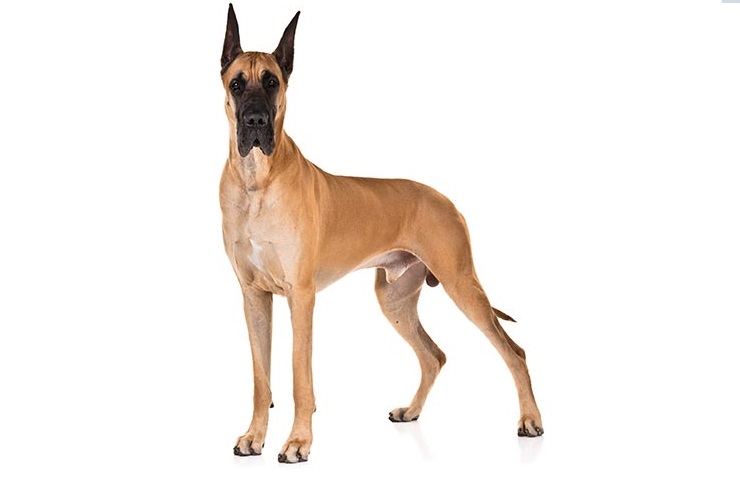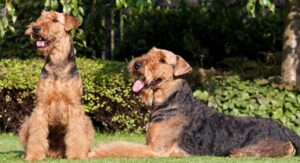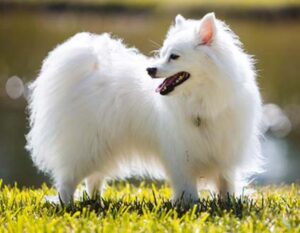What is Great dane Dog Breed ?
The Great Dane is a breed of large, muscular dog that is known for its impressive size, powerful build, and elegant appearance. Great Danes are often referred to as “gentle giants” due to their calm and friendly nature, despite their imposing size. They are typically friendly, intelligent, and good-natured dogs that are well-suited to life as family pets.

Great Danes have a long, smooth coat that can be fawn, brindle, blue, black, harlequin, or mantle in color. They have a tall, slender build and a long, narrow head with a tapered muzzle and large, floppy ears. They are generally well-proportioned, with a strong, muscular body and long, slender legs.
Great Danes are known for their versatility and can excel in a variety of roles, including as working dogs, therapy dogs, and show dogs. They are also popular as companion animals and are generally good with children and other pets. However, due to their large size and energetic nature, they do require plenty of space and regular exercise to remain healthy and happy.
Is Great Dane a good family dog?
Great Danes are generally considered to be good family dogs due to their calm and friendly nature. They are intelligent, good-natured dogs that are typically patient and gentle with children. They are also known to be good with other pets, making them a good choice for families with multiple animals.
However, it’s important to keep in mind that every dog is an individual and may have its own unique personality and needs. It’s important to carefully consider whether a Great Dane is the right breed for you and your family based on your lifestyle, living situation, and experience with dog ownership.
Great Danes are large, energetic dogs that require plenty of space and regular exercise to stay healthy and happy. They are not well-suited to apartment living or small living spaces, and they may not be the best choice for families with very young children due to their size and strength. It’s also important to be prepared to invest the time and effort required to properly train and socialize a Great Dane to ensure that it becomes a well-behaved, well-adjusted member of the family.
What breeds Make a Great Dane ?
Great Danes are a purebred dog breed that has been recognized by major kennel clubs around the world. They are not a mixed breed or a hybrid, but rather a breed that has been developed over many years through selective breeding.
The Great Dane breed is thought to have originated in Germany, where it was originally known as the “German Mastiff.” It is believed to have been developed by crossing various mastiff-type breeds with greyhounds, giving the Great Dane its unique combination of size, strength, and athleticism.
Great Danes are not known to be the result of a specific cross between two other breeds. Instead, they are a distinct breed that has been developed through selective breeding over many years to produce dogs with specific characteristics and traits.
Why is Great Dane so big?
Great Danes are known for their impressive size, with males often standing over 30 inches tall at the shoulder and weighing over 100 pounds. They are one of the tallest dog breeds in the world, and their large size is one of the breed’s most distinctive characteristics.
Great Danes are large because they were originally bred to be working dogs, specifically as hunting dogs and guard dogs. They were developed to be strong, powerful, and athletic, with the size and strength needed to perform their intended tasks. Over time, breeders focused on developing dogs with these characteristics, which resulted in the Great Dane breed as we know it today.
It’s worth noting that size is not the only factor that determines a Great Dane’s overall health and well-being. Proper nutrition, exercise, and veterinary care are also important for maintaining the health and happiness of Great Danes and other large breeds.
How smart are Great Danes?
Great Danes are generally considered to be intelligent dogs that are easy to train and learn quickly. They are known to be good at picking up new commands and tricks, and they are often eager to please their owners.
However, it’s important to keep in mind that every dog is an individual and may have its own unique personality and learning style. Some Great Danes may be more intelligent or easier to train than others, just as is the case with any breed.
Overall, Great Danes have a good reputation for being intelligent and responsive to training, which can make them a good choice for families looking for a smart and trainable companion. As with any breed, it’s important to provide your Great Dane with consistent, positive training and socialization to help it become a well-behaved and well-adjusted member of the family.
What dog has the best IQ?
It is difficult to accurately measure the intelligence of a dog, and there is no widely accepted way to determine which breed has the “best” IQ. Different dogs have different strengths and abilities, and intelligence can be expressed in many different ways. Some dogs may excel in obedience training, while others may be more skilled at problem-solving or adapting to new situations.
That being said, some breeds are generally considered to be more intelligent than others based on their ability to learn commands and perform tasks. Breeds that are often cited as being particularly intelligent include Border Collies, Poodles, German Shepherds, Golden Retrievers, and Australian Shepherds. However, it’s important to keep in mind that individual dogs within these breeds may vary in their intelligence and ability to learn.
Ultimately, the intelligence of a dog is just one factor to consider when choosing a breed. It’s important to choose a breed that is well-suited to your lifestyle, living situation, and experience with dog ownership, and to provide your dog with proper training, socialization, and care to help it reach its full potential.
Why Do Great Danes only live 7 years?
Great Danes are a large breed of dog and, like all large breeds, they tend to have a shorter lifespan compared to smaller breeds. On average, Great Danes live 7 to 10 years, although some individuals may live longer or shorter lives depending on various factors.
There are several reasons why Great Danes and other large breeds may have a shorter lifespan. One reason is that they are more prone to certain health problems that can shorten their lives, such as hip dysplasia, heart conditions, and cancer. Large breeds also tend to age more quickly than smaller breeds, which can contribute to a shorter lifespan.
It’s important to note that the lifespan of a Great Dane can vary significantly depending on a variety of factors, including genetics, diet, exercise, and overall health. Providing your Great Dane with good nutrition, regular exercise, and preventive care can help to extend its lifespan and promote overall health and well-being.
What’s the lifespan of a Great Dane?
The lifespan of a Great Dane is typically 7 to 10 years. This is relatively short compared to the lifespan of smaller breeds, which can live 12 to 15 years or more.
It’s important to note that the lifespan of a Great Dane can vary significantly depending on a variety of factors, including genetics, diet, exercise, and overall health. Providing your Great Dane with good nutrition, regular exercise, and preventive care can help to extend its lifespan and promote overall health and well-being.
It’s also worth noting that the lifespan of a Great Dane can vary based on the specific health conditions that the dog may be prone to. Some Great Danes may be more prone to certain health problems, such as hip dysplasia, heart conditions, and cancer, which can shorten their lifespan. It’s important to work with a veterinarian to address any health issues that may arise and to provide your Great Dane with the care it needs to live a healthy and happy life.
Do Great Danes like to be held?
It’s possible that some Great Danes may enjoy being held or cuddled, especially if they have been socialized and trained to be comfortable with physical affection. Great Danes are generally known to be calm, friendly, and good-natured dogs that are well-suited to life as family pets.
What will be meal for Great Dane ?
Great Danes are large, active dogs that require a high-quality diet to meet their nutritional needs. A good diet for a Great Dane should be balanced and provide the right mix of protein, fat, carbohydrates, vitamins, and minerals to support growth, development, and overall health.
It’s generally recommended to feed Great Danes a diet that consists of high-quality dry kibble that is formulated specifically for large breed dogs. Look for a kibble that is made with high-quality protein sources, such as meat or fish, and that is formulated to meet the nutritional needs of large breeds.
It’s also a good idea to feed your Great Dane a diet that is appropriate for its age and activity level. Puppies and growing dogs have different nutritional needs than adult dogs, and active dogs may require more calories and nutrients than less active dogs.
It’s important to work with a veterinarian or a canine nutritionist to determine the right diet for your Great Dane based on its individual needs and circumstances. They can help you choose the right type and amount of food to feed your Great Dane to ensure that it stays healthy and happy.
However, it’s important to keep in mind that every dog is an individual and may have its own unique personality and preferences. Some Great Danes may be more affectionate and enjoy being held more than others, while others may be more independent and prefer to have their own space.
It’s important to respect your Great Dane’s boundaries and not force physical affection if it is not welcome. It’s also important to be mindful of your Great Dane’s size and strength, and to be careful when handling it to avoid accidental injury.



